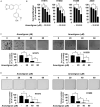Anwulignan is a novel JAK1 inhibitor that suppresses non-small cell lung cancer growth
- PMID: 33523587
- PMCID: PMC7933975
- DOI: 10.1111/jcmm.16289
Anwulignan is a novel JAK1 inhibitor that suppresses non-small cell lung cancer growth
Abstract
Anwulignan is a monomer compound derived from Schisandra sphenanthera lignans. It has been reported to possess a spectrum of pharmacological activities, including anti-bacterial, anti-inflammatory, anticancer and hepatoprotective properties. However, its anticancer capacity and molecular mechanism(s) against non-small cell lung cancer (NSCLC) have not been fully elucidated. Anwulignan significantly inhibited cell growth and increased G1-phase cell cycle arrest in NSCLC cells. Anwulignan strongly attenuates the JAK1/STAT3 signalling pathway by directly targeting JAK1 protein kinase activity in vitro. The anticancer activity by Anwulignan is dependent upon the JAK1 protein expression. Remarkably, Anwulignan strongly inhibited tumour growth in vivo. In conclusion, Anwulignan is a novel JAK1 inhibitor that may have therapeutic implications for NSCLC management.
Keywords: Anwulignan; JAK1; NSCLC; STAT3; cell-derived xenograft.
© 2021 The Authors. Journal of Cellular and Molecular Medicine published by Foundation for Cellular and Molecular Medicine and John Wiley & Sons Ltd.
Conflict of interest statement
None of the authors have any competing interests.
Figures






Similar articles
-
Synthesis, Antiproliferative Activity and Molecular Docking Analysis of Both Enantiomerically Pure Decursin Derivatives as Anticancer Agents.Chem Pharm Bull (Tokyo). 2024 May 25;72(5):498-506. doi: 10.1248/cpb.c23-00718. Epub 2024 May 11. Chem Pharm Bull (Tokyo). 2024. PMID: 38735699
-
Inhibition of JAK1/2 can overcome EGFR-TKI resistance in human NSCLC.Biochem Biophys Res Commun. 2020 Jun 18;527(1):305-310. doi: 10.1016/j.bbrc.2020.04.095. Epub 2020 May 11. Biochem Biophys Res Commun. 2020. PMID: 32446385
-
Activation of IL-6R/JAK1/STAT3 signaling induces de novo resistance to irreversible EGFR inhibitors in non-small cell lung cancer with T790M resistance mutation.Mol Cancer Ther. 2012 Oct;11(10):2254-64. doi: 10.1158/1535-7163.MCT-12-0311. Epub 2012 Aug 13. Mol Cancer Ther. 2012. PMID: 22891040
-
miR-140-3p inhibits progression of non-small cell lung cancer by targeting Janus kinase 1.J Biosci. 2020;45:48. J Biosci. 2020. PMID: 32345774
-
Rab1A promotes IL-4R/JAK1/STAT6-dependent metastasis and determines JAK1 inhibitor sensitivity in non-small cell lung cancer.Cancer Lett. 2021 Dec 28;523:182-194. doi: 10.1016/j.canlet.2021.10.008. Epub 2021 Oct 8. Cancer Lett. 2021. PMID: 34627950
Cited by
-
A promising natural product in diffuse large B-cell lymphoma therapy by targeting PIM1.Ann Hematol. 2024 Aug;103(8):2905-2915. doi: 10.1007/s00277-024-05670-7. Epub 2024 Mar 1. Ann Hematol. 2024. PMID: 38424303
-
Pharmacological Effects of Polyphenol Phytochemicals on the JAK-STAT Signaling Pathway.Front Pharmacol. 2021 Sep 3;12:716672. doi: 10.3389/fphar.2021.716672. eCollection 2021. Front Pharmacol. 2021. PMID: 34539403 Free PMC article. Review.
-
Anwulignan Alleviates Bone Cancer Pain by Modulating the PPARα/CXCR2 Signaling Pathway in the Rat Spinal Cord.CNS Neurosci Ther. 2025 Mar;31(3):e70302. doi: 10.1111/cns.70302. CNS Neurosci Ther. 2025. PMID: 40079428 Free PMC article.
-
Identification of Potent and Selective JAK1 Lead Compounds Through Ligand-Based Drug Design Approaches.Front Pharmacol. 2022 Apr 21;13:837369. doi: 10.3389/fphar.2022.837369. eCollection 2022. Front Pharmacol. 2022. PMID: 35529449 Free PMC article.
-
Green Seaweed Caulerpa racemosa as a Novel Non-Small Cell Lung Cancer Inhibitor in Overcoming Tyrosine Kinase Inhibitor Resistance: An Analysis Employing Network Pharmacology, Molecular Docking, and In Vitro Research.Mar Drugs. 2024 Jun 12;22(6):272. doi: 10.3390/md22060272. Mar Drugs. 2024. PMID: 38921583 Free PMC article.
References
-
- Bray F, Ferlay J, Soerjomataram I, Siegel RL, Torre LA, Jemal A. Global cancer statistics 2018: GLOBOCAN estimates of incidence and mortality worldwide for 36 cancers in 185 countries. CA Cancer J Clin. 2018;68:394‐424. - PubMed
-
- Torre LA, Siegel RL, Jemal A. Lung cancer statistics. Adv Exp Med Biol. 2016;893:1‐19. - PubMed
-
- Lim SM, Syn NL, Cho BC, Soo RA. Acquired resistance to EGFR targeted therapy in non‐small cell lung cancer: Mechanisms and therapeutic strategies. Cancer Treat Rev. 2018;65:1‐10. - PubMed
-
- Duruisseaux M, Esteller M. Lung cancer epigenetics: From knowledge to applications. Semin Cancer Biol. 2018;51:116‐128. - PubMed
Publication types
MeSH terms
Substances
Grants and funding
LinkOut - more resources
Full Text Sources
Other Literature Sources
Research Materials
Miscellaneous

